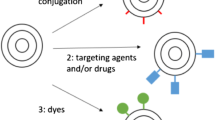Abstract
The interactions between polycationic poly-lysine dendrimers and hydrophobic fluorescent probes (anionic ANS and neutral Prodan) were studied. R121 and R131 dendrimers were not able to interact with anionic and neutral hydrophobic groups. R124 was able to interact with neutral and anionic hydrophobic fluorescent probes, however mainly through hydrophobic forces. Dendrimers R155 and R169 showed the maximal effects. The strongest interactions observed for R169 can be explained by intramolecular folding (stacking) of its two L-proline residues. Using double fluorescence titration technique for ANS probe allowed to receive such constant of binding and the number of binding centers: for R121, 1.8·103 (mol/l)−1 and 1.07; for R124, 12.1·103 (mol/l)−1 and 0.48; for R131, 4.7·103 (mol/l)−1 and 0.48; for R155, 9.2·103 (mol/l)−1 and 1.36; for R169, 39.6·103 (mol/l)−1 and 0.97. Thus, neutral and anionic hydrophobic probes can be used for the fast preliminary screening of binding properties of newly synthesized polycationic dendrimers.






Similar content being viewed by others
References
Tomalia DA, Baker H, Ewald JR, Hall M, Kallos G, Martin S, Roeck J, Ryder J, Smith P (1985) Polym J 17:117–132
Newkome GR, Yao ZQ, Baker GR, Gupta VK (1985) J Org Chem 50:2003–2006
Fisher M, Vogtle F (1999) Angew Chem Int Ed 38:884–905
Cloninger MJ (2002) Current Opinion Chem Biol 6:742–748
Tam JP, Yang JL, Lu Y-A (2002) Eur J Biochem 269:923–932
Okuda T, Sugiyama A, Niidama T, Aoyagi H. (2004) Biomaterials 25:537–544
Bhadra D, Bhadra S, Jain NK (2004) Proceedings of the 2004 International Conference on MEMS, NANO and SMART Systems
Bourne N, Stanberry LR, Kern ER, Holan G, Matthews B, Bernstein DI (2000) Antimicrob Agents Chemother 44:2471–2474
Klajnert B, Janiszewska J, Urbanczyk-Lipkowska Z, Bryszewska M, Shcharbin D, Labieniec M (2006) Int J Pharm 309:208–217
Jones NJ, Osborn MJ (1977) J Biol Chem 252:7398–7404
Chen CZ, Cooper SL (2002) Biomaterials 23:3359–3368
Janiszewska J, Switon J, Lipkowski AW, Urbanczyk-Lipkowska Z (2003) Bioorg Med Chem Lett 13:3711–3713
Tam JP, Lu Y-A, Yang J-L (2002) Eur J Biochem 269:923–932
Matulis D, Baumann Ch, Bloomfield V, Lovrien R (1999) Biopolymers 49:451–458
Slavik J (1982) Biochim Biophys Acta 694:1–25
Scatchard G (1949) Ann NY Acad Sci 51:660–672
Lakowicz JR (1999) Principles of Fluorescence Spectroscopy. 2nd ed., Kluwer Acadmic Publisher, Dordrecht
Shcharbin D, Klajnert B, Mazhul V, Bryszewska M (2003) J Fluoresc 13:519–524
Shcharbin D, Klajnert B, Mazhul V, Bryszewska M (2005) J Fluoresc 15:21–29
Prodan. http://probes.invitrogen.com/handbook/sections/1305.html
Kusube M, Matsuki H, Kaneshina Sh (2005) Colloids and Surf B 42:79–88
Sengupta B, Guharay J, Sengupta PK (2000) Spectrochimica Acta Part A 56:1433–1441
Hutterer R, Schneider FW, vSprinz H, Hof M (1996) Biophys Chem 61:151–160
Cramb DT, Beck SC (2000) J Photochem Photobiol A 134:87–95
Bodanszky M, Bodanszky A (1984) The Practice of Peptide Synthesis. Springer-Verlag, Berlin
Stryer L (1965) J Mol Biol 13:482–495
Radda GK (1971) Curr Top Bioenerg 4:81–123
Schoenbrunn E, Eschenburg S, Luger K, Kabsch W, Amrhein N (2000) PNAS 97:6345–6349
Schobert B, Tschesche H (1978) Biochim Biophys Acta 541:270–277
Sankararamakrishnan R, Vishveshwara S (1990) Biopolymers 30: 287–298
Che Y, Marshall GR (2006) Biopolymers 81:392–406
Galzitskaya O, Caflisch A (1999) J Mol Graph Model 17:19–27
Acknowledgements
Dr. Dzmitry Shcharbin is a beneficiary of a Marie Curie International Incoming Fellowship within the 6th EU Framework Programme (grant 510018).
Author information
Authors and Affiliations
Corresponding author
Rights and permissions
About this article
Cite this article
Jokiel, M., Shcharbin, D., Janiszewska, J. et al. The Interaction between Polycationic Poly-Lysine Dendrimers and Charged and Neutral Fluorescent Probes. J Fluoresc 17, 73–79 (2007). https://doi.org/10.1007/s10895-006-0141-5
Received:
Accepted:
Published:
Issue Date:
DOI: https://doi.org/10.1007/s10895-006-0141-5




